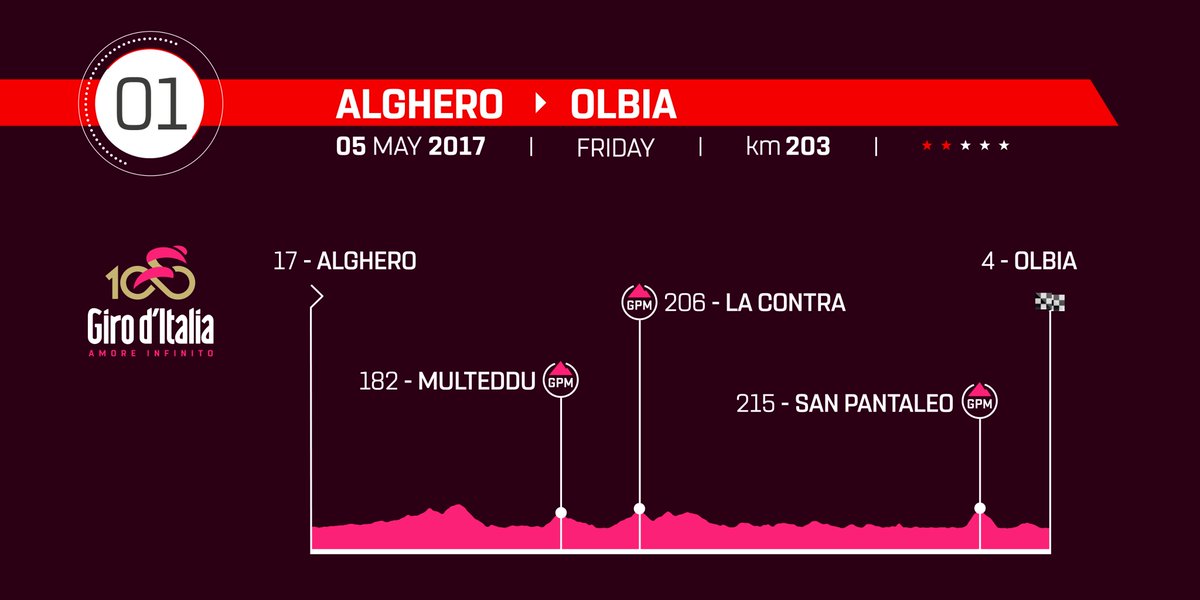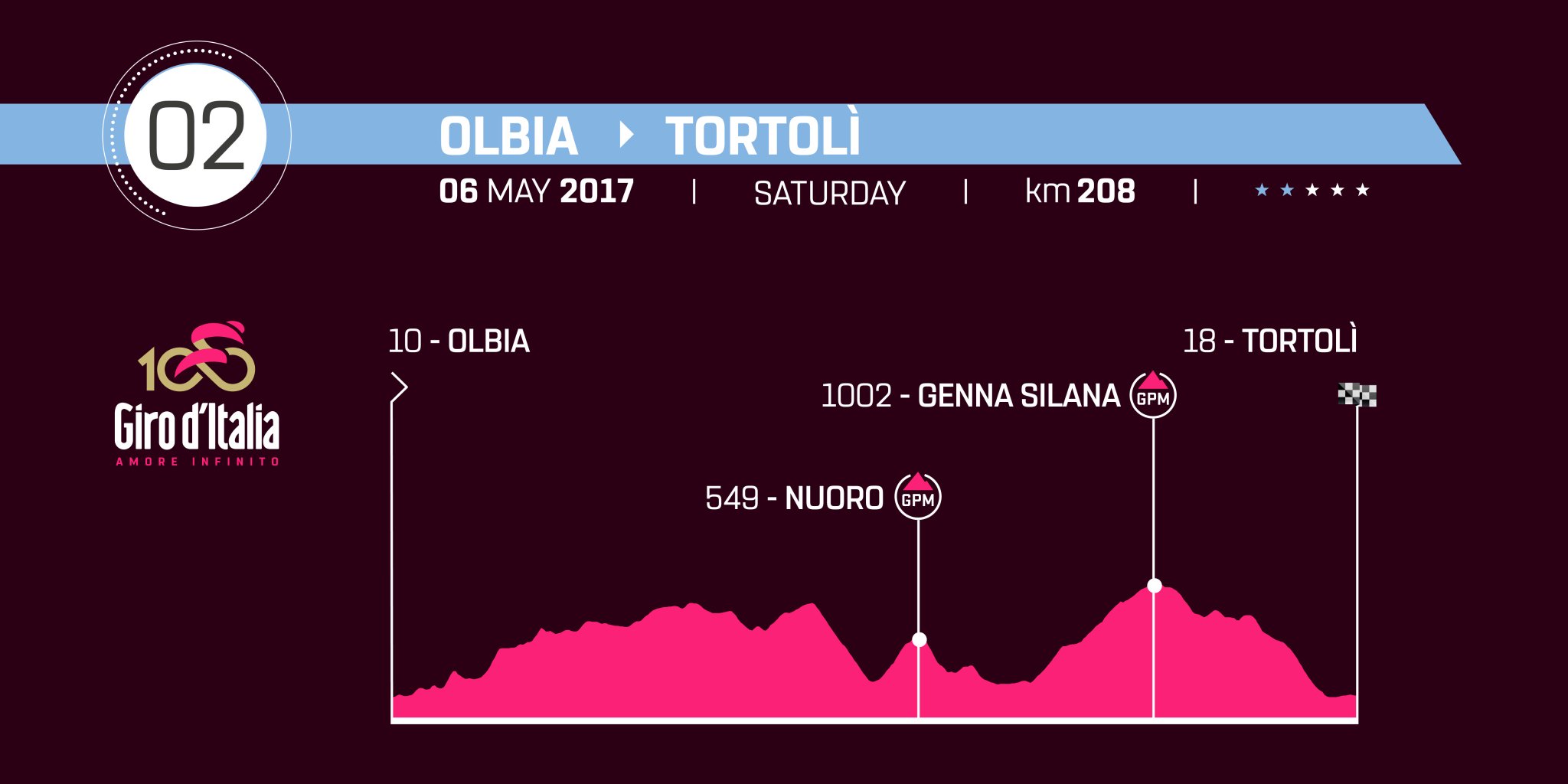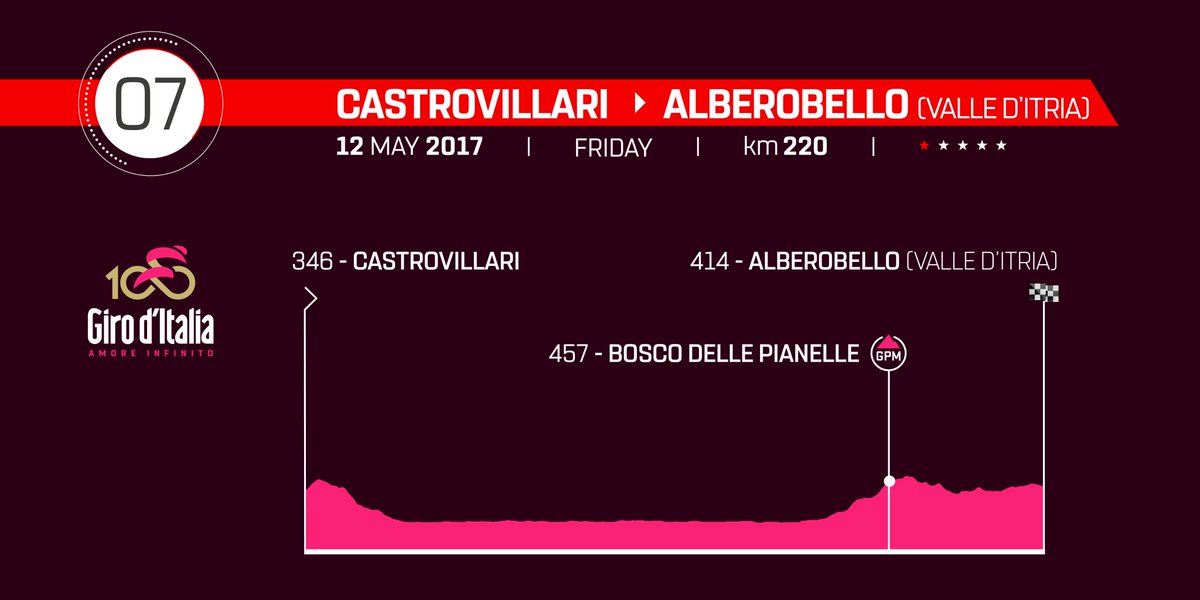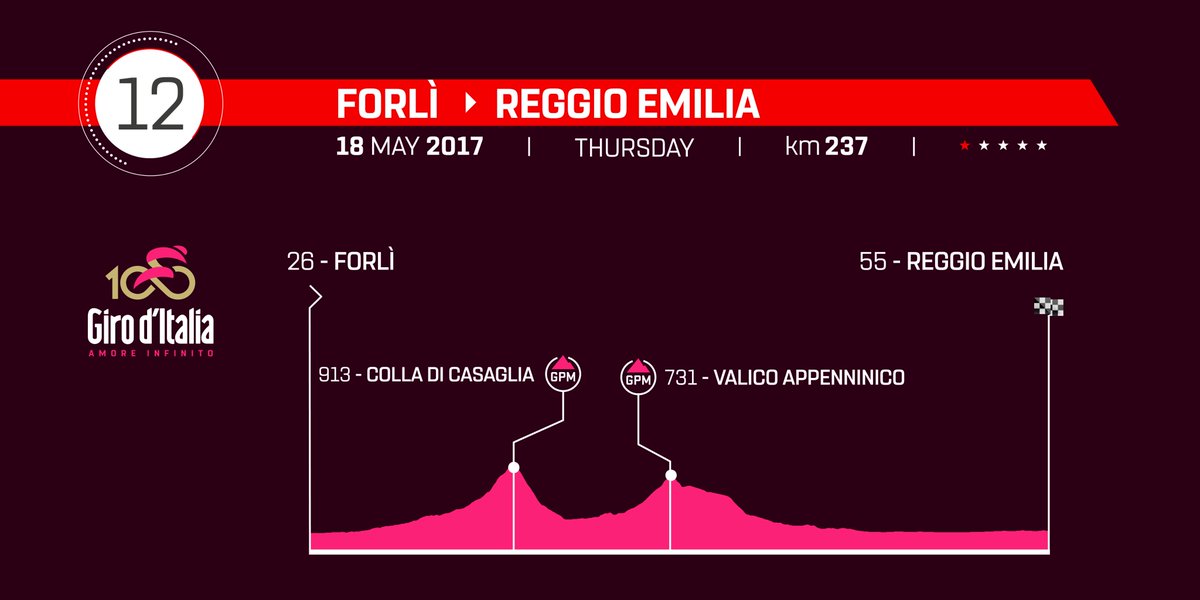
The 100th Giro D'Italia will start in Sardinia on May 5th, it was announced as the 2017 edition was launched in Milan.
On 5 May, the Giro d’Italia will start from
Sardinia and return to the Italian peninsula after two stages in Sicily.
The final stage will see the peloton arrive in Milan for the 76th time, on 28
May. This year’s race features many stages in the south of the country, creating
a journey through an Italy that is yet to be discovered by the Giro.
The Corsa Rosa will pay tribute to many former
champions (Bartali, Coppi, Pantani, to name just a few) and places that have
shaped the history of the country, and will maintain a special focus on the
spirit of solidarity.
The race will include six
sprint stages, eight stages of medium difficulty climbing, five highly testing
climbing stages and two individual time trials (for a total of 67.2km) including
the stage that will close the 100th Giro, from the famous Monza racetrack to the
Milan Cathedral. The iconic Stelvio Pass is the 2017 Cima Coppi.
Many previous Giro winners attended the new route’s
presentation, together with the UCI President, Brian Cookson, and many cycling
enthusiasts. A speech byUrbano Cairo, CEO of the RCS MediaGroup,
opened the day’s session.
This year’s route, from Sardinia to Milan, takes in many of the cities, places and people that have shaped the history of Italy and of the Corsa Rosa. The 100th edition of the Giro d’Italia - organized by RCS Sport/La Gazzetta dello Sport - is not just a sporting spectacle but also a cultural and social event that will once again shine the international spotlight on Italy, highlighting its traditions, its values and the importance of "Made in Italy". The Giro does not forget the spirit of solidarity, promoting initiatives for the benefit of those people affected by the earthquake of 24 August 2016. "Amore Infinito" (Never-ending Love) is the new slogan – capturing the emotions of the race – that will feature throughout the Giro d’Italia’s communications.
The race starts from Sardinia with three stages that suit sprinters and finisseurs. This is the third Big Start from the island, after those of 1991 and 2007. The first rest day, on Monday 8 May, sees the transfer to Sicily. On Tuesday 9 May, the stage starting from Cefalù features the first uphill finish of the 100th Giro, on the Etna summit. Wednesday 10 brings a new stage for sprinters with the finish line in Messina, the birthplace of Vincenzo Nibali, having started in Pedara, on the slopes of Mt Etna.
The race continues with three stages between Calabria and Puglia. The Reggio Calabria-Terme Luigiane stage and the Castrovillari-Alberobello stage (the latter being famous worldwide for its Trulli, which are protected as a Unesco World Heritage site), and the following stage which starts from Molfetta and finishes in Peschici, through the scenic roads of the Gargano. The Montenero di Bisacce-Blockhaus, the second summit finish of the race, closes the second weekend of the Giro.
On Monday 15 May, the second rest day, in Foligno, is dedicated to solidarity, with initiatives and events in support of people of the areas hit by the earthquake of 24 August 2016.
The first spectacular individual time trial (39.2km), among the vineyards of Sagrantino between Foligno and Montefalco, will be held on Tuesday 16. Wednesday 17 May’s very tricky stage through the Tuscan-Emilian Apennines is in memory of the cycling icon, Gino Bartali. The stage will proceed to Florence, with km 0 in Ponte a Ema, where the great champion was born – just in front of the museum dedicated to him – and continues towards Bagno di Romagna.
Saluting former champions
The next day’s Forlì-Reggio Emilia stage brings two events to mind: the start city, Forlì, is where Ercole Baldini (winner of the 1958 Giro) was born; while the city where the stage ends, Reggio Emilia, is the birthplace of the first Italian tricolour flag, 220 years ago – on 7 January 1797.
On Friday 19 the race resumes from Reggio Emilia to head in Piedmont with an arrival and a departure dedicated to the “Campionissimo”, Fausto Coppi, five times winner of the Giro d’Italia. The finish line of the 13th stage is in Tortona where Coppi died on 2 January 1960. Then stage 14 starts in Castellania, birthplace of “the Heron”. This stage, from Castellania to Santuario di Oropa, could be called the “Coppi-Pantani stage”, in memory of two champions who have written indelible pages in the history of cycling and of the Giro, and who are also united by a tragic ending.
The 15th stage, from Valdengo to Bergamo, has a finish very similar to that of Il Lombardia 2016 (Miragolo San Salvatore, Selvino and final climb in Bergamo Alta) won by Esteban Chaves. Then follows the final rest day, in the “Città dei Mille” (City of the Thousand), so named by General Giuseppe Garibaldi, given the high number of garibaldini soldiers from Bergamo. Felice Gimondi, winner of three Giro d’Italia, was born in the Orobic city. He was the protagonist of many epic battles with Eddy Merckx on the Giro’s roads, in the 60s and 70s.
Into the mountains
The Tirano-Canazei stage, on Wednesday 24 May, with Aprica, Tonale and Giovo before the finish line, may present a good opportunity for a long distance attack. On 25 May, the Queen Stage, the “Tappone Dolomitico” from Moena to Ortisei, with four mountain passes (Pordoi, Valparola, Gardena and Pinei) looks set to be crucial in deciding the GC.
San Candido-Piancavallo, on 26 May, includes the race’s fourth summit finish: it features the challenging climbs of the Monte Croce Comelico and Passo di Selva Chianzutan, before a summit finish in Piancavallo. The Pordenone – Altopiano di Asiago stage begins flat, but has an uphill finish. The Monte Grappa (which, after many years, will be climbed from the north side) will lead to the finish in Asiago, coming from an unusual side of the Altopiano, from Valstagna.
A 'race of truth' to finish
Then the final, 28km, individual time trial course starts at the Autodromo Nazionale in Monza and finishes in front of the Milan Cathedral, the Duomo. Ending with ‘the race of truth’ could reshuffle the cards and it will certainly crown the winner of this historic edition in style.
CURIOSITIES
- For the third time in its history, the Giro starts from Sardinia (after 1991 and 2007).
- Sicily has so far hosted 42 stages of the Corsa Rosa. The first summit finish on the Etna was won by Franco Bitossi in 1967, exactly 50 years before the next Etna finish.
- The Blockhaus will celebrate the 50th anniversary of its appearance, in the 100th edition of the race. The first time was on 31 May 1967 with victory by Eddy Merckx on Italo Zilioli.
- The first individual time trial in the Giro d’Italia was the Bologna-Ferrara, on 22 May 1933, won by Alfredo Binda. In total there have so far been 162 individual time trials. The longest was the Perugia-Terni, in 1951 (81km), won by Fausto Coppi.
- The Giro has never previously had a stage start or finish in Castellania, while Tortona was the finish of the arrival of Meda-Tortona 1989 (70 years after the birth of Coppi), stage won by Jesper Skibby. Tortona and Castellania are the birth and death places, respectively, of Fausto Coppi.
- Oropa welcomes a Giro stage finish for the sixth time (following 1963, 1993, 1999, 2007 and 2014). All the previous victories there have gone to Italian riders.
- The first finish in Bormio belongs in cycling legend: in 1953, Koblet starts from Bolzano in the Pink Jersey, only for his rival, Coppi, to attacks on the Stelvio and win the stage, the Pink Jersey and the Giro d’Italia. In 2017 the Corsa Rosa will arrive in Bormio for the seventh time.
- Only two stages have previously ended in Ortisei, which is famous for 1940’s Pieve di Cadore-Ortisei, where Gino Bartali attacked on the Falzarego, the first of three hills, with Pordoi and Sella to follow. The only riders who managed to follow him were Enrico Mollo and a 20-year-old Fausto Coppi (Pink Jersey), who had been in trouble the previous day on the Mauria pass. Bartali and Coppi arrived on the finish, two minutes ahead of Mollo - and Coppi went on to claim that year’s Giro; the youngest ever winner. The day following the end of the Giro, on 10 June 1940, Italy entered the Second World War.
- For the ninth time, the Stelvio is the Cima Coppi of the Giro d'Italia.
- The Giro has finished in Milan 75 times.
![]()
The opening stage will be on May 5th with a 203km stage from Alghero to Olbia followed by stages from Olbia toTortolì (208km) and Tortolì to Cagliari (148km).




















Source: DSG
